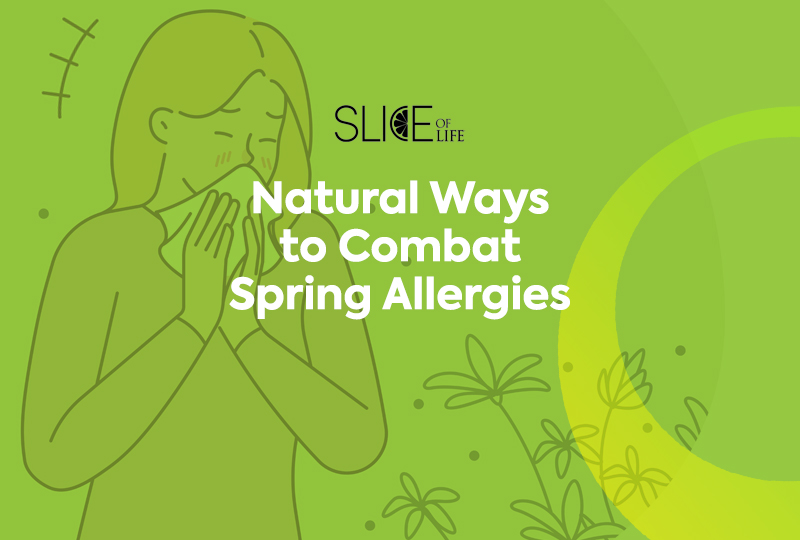Spring has most certainly sprung, and along with it, that familiar yellow coating called pollen. And it is not there spreading joy! Anyone who has seasonal allergies or is like me and suffers from asthma, you know exactly what I am talking about. So, what can we do to combat these symptoms? There are certainly enough drugs out there advertising instant relief, but as many of us know from the knowledge we have learned working and studying at Life University (Life U), there are better and more effective solutions that come to us through nature and don’t leave the short- and long-term side effects that pharmaceuticals can.
According to WebMD, here are eight ways to combat allergies without drugs.
- Acupuncture. In this ancient Chinese therapy, an expert sticks tiny needles gently – and many people say painlessly – into your skin at specific points. Studies of acupuncture for the treatment of allergies have shown mixed results, with the most rigorous studies showing very modest clinical benefit. Acupuncture may be a reasonable option for interested patients with relatively mild disease who wish to minimize medication use and find the cost of therapy acceptable.
- Allergy-proofing your home. You can’t stop pollen from blowing outside, but you do have some control over what happens inside your home. Keep your windows shut when pollen is in the air. Run the air conditioning instead. If you can, change your clothes before coming inside (or as soon as you get in), remove your shoes and shower.
- Helpful foods. Eating something spicy can thin mucus and clear congestion. A teaspoon of honey can soothe your throat if it gets irritated from coughing all day. Children under a year old should never be given honey.
- HEPA filters. Studies are mixed about whether air filters help with allergy symptoms. That’s because far more allergens rest on surfaces like rugs, furniture and countertops than simply hang in the air. Therefore, cleaning is an important step in controlling your allergy and asthma If you buy an air filter, make sure it’s a HEPA filter. These capture fine, pollen-sized particles. It’s a good idea to get a vacuum cleaner with a HEPA filter, too. Regular vacuums can blow allergens back into the air.
- Nasal washes.You could use a saline solution (saltwater) in a neti pot or a squeeze bottle to rinse out your sinuses. Use distilled or sterile water. If you use tap water, you must boil it and let it cool off first or filter it with a filter that says “NSF 53”, “NSF 58” or “absolute pore size” of 1 micron or smaller. Clean the bottle or neti pot after every use, also using distilled, sterile, boiled or filtered water.
- If it’s allergy season, keep your triggers at bay. Don’t do outdoor activities when pollen counts are high. Most pollen peaks between 5:00-10:00 a.m. each day and can also be high around midday when it’s warm and windy. And anytime you garden or clean the garage, wear a dust mask and sunglasses to keep allergens out of your nose, mouth and eyes.
- Saline sprays. These over-the-counter saltwater sprays can flush out your nasal passages. They help clear out pollen and other irritants.
- Supplements. There’s evidence that some supplements help nasal allergies. Butterbur is one of the most promising and well-researched. Studies show that butterbur – specifically a butterbur extract called Ze 339 – works as well as some allergy drugs. Still, butterbur has been linked to liver damage. Those interested in using it should also be aware of this potential hazard and be advised about early symptoms. Fermented red ginseng resulted in significant improvement in nasal congestion and rhinitis quality of life. An Indian herbal product containing extract from the stem of Tinospora cordifolia has been shown in studies to give significant improvement in sneezing, nasal discharge, nasal obstruction and itchy nose, but it can raise your white blood cell count. There’s evidence that other supplements, such as quercetin and bromelain, may help too
- Chiropractic care. Additionally, a medical study published in 2004 (https://cedarparkchiro.com/chiropractic-provides-an-evidenced-based-solution-to-seasonal-allergies/) linked allergies to tiny misalignments in the spine. When the misalignments were addressed with manual adjustments by a health professional, allergy symptoms improved in more than 70% of patients. Several other recorded results included:
– 98% of patients with dermatitis, allergies and asthma suffered from vertebral misalignments.
– Correction of spinal misalignments improved itching symptoms of chronic dermatitis by 88% and skin appearance of dermatitis patients by 72%.
– Allergy symptoms improved in over 70% of patients who received adjustments.
– Vertebral misalignment is a common factor in patients with dermatitis and asthma.
– Dermatitis patients receiving no adjustment experienced no improvement.


Social Media